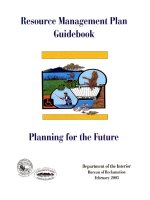negotiation planning
Bạn đang xem bản rút gọn của tài liệu. Xem và tải ngay bản đầy đủ của tài liệu tại đây (174.68 KB, 25 trang )
Session 4
Negotiation Planning
Goals – The Focus That Drives
Negoaon Strategy
•
Determining goals is the first step
in the negotiation process
•
Negotiators should specify goals
and objectives clearly
•
The goals set have direct and
indirect effects on the negotiator’s
strategy
Goals, Strategy and Planning
The Direct and Indirect Eects of
Goals on Strategy
•
Direct effects
–
Wishes are not goals
–
Goals are often linked to the other party’s
goals
–
There are limits to what goals can be
–
Effective goals must be concrete/specific
•
Indirect effects
–
Forging an ongoing relationship
Strategy versus Taccs
•
Strategy: The overall plan to achieve one’s
goals in a negotiation
•
Tactics: Short-term, adaptive moves
designed to enact or pursue broad strategies
–
Tactics are subordinate to strategy
–
Tactics are driven by strategy
•
Planning: The “action” component of the
strategy process; i.e. how will I implement
the strategy?
Approaches to Strategy
•
Unilateral: One that is made without
active involvement of the other party
•
Bilateral: One that considers the
impact of the other’s strategy on
one’s own
Strategic Opons
•
Choice of strategy is reflected in the
answers to two questions:
–
How much concern do I have in
achieving my desired outcomes at
stake in the negotiation?
–
How much concern do I have for the
current and future quality of the
relationship with the other party?
The Dual Concerns Model
Avoidance: Don’t negotiate
Competition: I gain, ignore relationship
Collaboration: I gain, you gain, enhance relationship
Accommodation: I let you win, enhance relationship
Understanding the Flow of
Negoaons: Stages and Phases
•
How does the interaction between
parties change over time?
•
How do the interaction structures
relate to inputs and outcomes over
time?
•
How do the tactics affect the
development of the negotiation?
Understanding the Flow of
Negoaons: Stages and Phases
Negotiation proceeds through distinct
phases or stages
•
Beginning phase (initiation)
•
Middle phase (problem solving)
•
Ending phase (resolution)
Key Steps to an
Ideal Negoaon Process
•
Preparation
–
What are the goals?
–
How will I work with the other party?
•
Relationship building
–
Understanding differences and similarities
–
Building commitment toward a mutually beneficial set
of outcomes
•
Information gathering
–
Learn what you need to know about the issues
Key Steps to an
Ideal Negoaon Process
Key Steps to an
Ideal Negoaon Process
•
Information using
–
Assemble your case
•
Bidding
–
Each party states their “opening offer”
–
Each party engages in “give and take”
•
Closing the deal
–
Build commitment
•
Implementing the agreement
Ge)ng Ready to Implement the
Strategy: The Planning Process
•
Define the issues
•
Assemble the issues and define the
bargaining mix
–
The bargaining mix is the combined
list of issues
•
Define your interests
–
Why you want what you want
Ge)ng Ready to Implement the
Strategy: The Planning Process
•
Know your limits and alternatives
•
Set your objectives (targets) and opening
bids (where to start)
–
Target is the outcome realistically
expected
–
Opening is the best that can be achieved
•
Assess constituents and the social context
of the negotiation
Ge)ng Ready to Implement the
Strategy: The Planning Process
•
Analyze the other party
–
Why do they want what they want?
–
How can I present my case clearly
and refute the other party’s
arguments?
•
Present the issues to the other party
Ge)ng Ready to Implement the
Strategy: The Planning Process
•
Define the protocol to be followed in
the negotiation
–
Where and when will the
negotiation occur?
–
Who will be there?
–
What is the agenda?
Developing a Reservaon Point
Step 1: Brainstorm Your Alternatives. Imagine that you want to sell your
house. Your target point—$275,000. What will you do in the event that you
do not get an offer of $275,000? Consider as many alternatives as possible.
Step 2: Evaluate Each Alternative. Order the various alternatives in terms of
their relative attractiveness, or value. If an alternative has an uncertain
outcome, such as reducing the list price, you should determine the
probability that a buyer will make an offer at that price. Suppose that you
reduce the list price to $265,000. Based on research, you assess the
probability of an offer to be 60%. The best alternative should be selected to
represent your BATNA.
Step 3: Attempt to Improve Your BATNA. In this case, you might contact a
rental company and develop your rental options, or you may make some
improvements that have high return on investment (e.g., new paint). Of
course, your most attractive BATNA is to have an offer in hand on your
house.
Step 4: Determine Your Reservation Price. The least amount of money you would accept for your home
at the present time. You assess the probability of an offer of $250,000 or higher to be 95%. You think
there is a 5% chance that you will not get such offer and will rent it. The probabilities always sum to
exactly 100%. We have considered all possible events occurring. No alternative is left to chance. You
can assess your expected probabilities of selling your house:
Reduce the price of your home to $265,000 P
sale
= 60%
Reduce the price of your home to $250,000 P
sale
= 35%
Rent the house P
rent
= 5%
An overall value for each of these “risky” alternatives is assessed by multiplying the value by its probability:
Value of reducing price to $265,000 = $265,000 x 0.6 = $159,000
Value of reducing price to $250,000 = $265,000 x 0.35 = $87,500
Value of renting the house = $100,000 x 0.05 = $5,000
Add all the values of the alternatives to arrive at an overall evaluation:
= 0.6($265,000) + 0.35($250,000) + 0.05($100,000) = $159,000 + $87,500+ $5,000 = $251,500
Developing a Reservaon Point
20
Informaon Gathering:
MOTIVATION FACTORS
•
Learn all about the parties involved.
–
Find out not only what they want,
what specifically motivates their
desires.
•
Learn about their communication
style and problem-solving approach.
21
Informaon Gathering:
Do Not Limit Yourself To What You Find In Print.
•
Studying the history of an organization.
•
Conversation Discuss the issues with "non-negotiating"
members of the organization. Often, individuals with no
apparentties to the discussions can be very influential in
affecting the outcome.
–
Talk outside the formal setting with the individuals involved in
the negotiation.
–
Take time to develop a relaxed and comfortable dynamic. A
solid relationship synergistically creates trust, which, in turn,
tends to unlock information.
–
The information you need to understand others' needs
and motivations won't always be at your fingertips.
Articles, Web pages, or your own knowledge of a company
or industry can prove to be a treasure chest of information.
22
Empathic Analysis
•
Ask yourself how does the other side
perceive my demands?
•
What is standing in the way of them
agreeing with me?
•
Do I know what my own underlying
interests are?
If you can figure out their interests as well
as your own, you will be much more likely
to find a solution that benefits both sides.
23
Empathic Analysis
•
Analyze the potential consequences
of an agreement you are advocating,
as the other side would see them.
–
Carrying out an empathetic analysis will help you
understand your adversary's interests.
–
Then you will be better equipped to negotiate an
agreement that will be acceptable to both of you.
•
Find out if there are multiple interests
each side is trying to satisfy.
Interest Map
•
An interest map shows positions
and deeper interests that link all
players in a negotiation.
•
By looking at an interest map, you
will know what information is
needed, which questions to be
asked and how to design an offer.
Player
1
Player
2
Player
3
Positions
-
-
Interests
-
-
Positions
-
-
Interests
-
-
Positions
-
-
Interests
-
-
Summary on the Planning Process
“ planning is the most
important activity in
negotiation.”
•
90% of planning occurs before
the negotiation.









